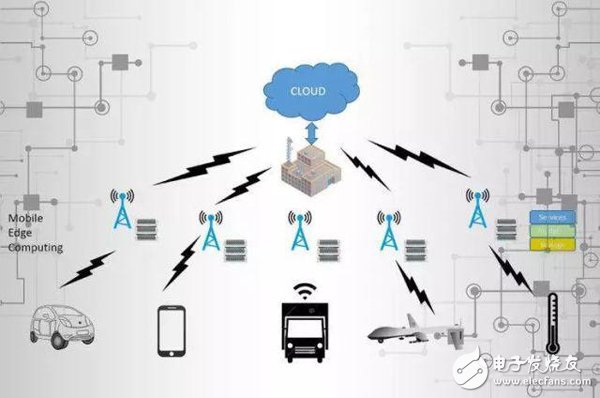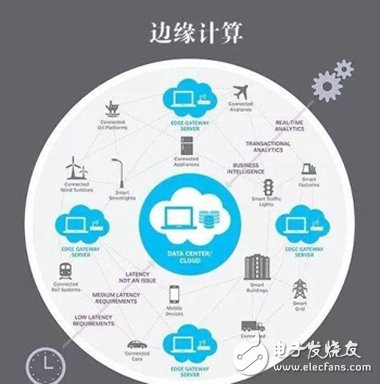With the development of the Internet of Things, edge computing has become one of the most popular technologies, leading to the layout of industry giants such as Huawei, Ali, ARM and Intel. So what is the sacred edge calculation and what kind of connection exists with the Internet of Things? And see below.
 I. The IoT Challenge of Cloud Computing
I. The IoT Challenge of Cloud Computing As the most important platform technology of the Internet, cloud computing can build large data centers, store and process large amounts of data centrally, and use the computing power of massive data centers to calculate and solve problems.
Since the advent and widespread use of cloud computing models at the beginning of this century, cloud computing has changed our lives, learning, and work. From Guizhou to Iceland, the data centers of large companies can be seen all over the world. For Amazon, Microsoft, Ali and Tencent, cloud computing platforms have also become a very important source of business and revenue.
However, with the advent of the Internet of Things era, cloud computing platforms will face difficult challenges such as massive device access, massive data, insufficient bandwidth and high power consumption. At the current level of bandwidth, data transfer between devices and the cloud is not yet supported, making it impossible for cloud computing centers to return data decisions in real time.
Thus, the edge calculation begins to enter the public's sight.
Second, the application of edge computing and its advantagesEdge computing is an open platform that integrates network, computing, storage, and application core capabilities on the edge of the network near the source or data source. The core of edge computing is to migrate computing tasks from the cloud computing center to the edge devices that generate the source data.
The edge computing IoT solution is divided into: sensing control layer, network layer, agile controller and application layer.
Sensing Control Layer: This layer contains a large number of sensors, control components (such as switches, etc.) and measuring components (such as electricity meters, etc.), as well as communication components. These communication components may be separate or combined with other components.
Network layer: This layer mainly implements convergence and interconnection. Its functions include edge calculation and on-site processing in addition to network connection and management, while ensuring local survival of services. Local survival and on-site processing are very important for the Internet of Things, especially for industrial and civil large facilities. In addition, protocol conversion is also an important function of this layer. There are a lot of protocols in the IoT field. These protocols come from the accumulation of various industry history. Therefore, it is necessary to convert the protocol on the gateway and carry the data uniformly on the IP network for transmission.
Agile controller: This layer performs unified processing on the data sent by the gateway and sends it up to the application layer. It also manages the underlying network, sensors, control components, measurement components, and computing resources, and provides automated tools for network deployment and configuration.
Business Application Layer: This layer is used in a variety of industry applications.

Since data is only exchanged between the source data device and the edge device, and is not all uploaded to the cloud computing platform, in the IoT application, compared with the traditional cloud computing, edge computing has absolute advantages in the following five aspects. :
1. Security requirements
In the cloud computing model, all data of the user needs to be uploaded to the data center, and in this process, data security becomes an important issue. From the electronic financial account password, to the search engine history to the smart camera monitoring, the process of uploading these personal privacy data to the data center implies the risk of data leakage.
This is one of the reasons why edge computing has won the favor of large industrial companies. At Honeywell's user group meeting last year, most customers of their industrial automation products were reluctant to put their wireless infrastructure in Honeywell's factory to avoid security breaches.
The hacking of Taggit’s violations (starting with the HVAC system and ultimately causing the customer’s credit card to be compromised) raises concerns about infrastructure hackers, but for certain industrial processes, Worry is absolutely necessary.
2. Intellectual property issues
In addition, related to security issues are concerns about proprietary data and intellectual property.
In cloud computing, all of the user's data needs to be uploaded to the data center, such as the refinery's refining process, the production recipe of the cola manufacturer, and other important information that is considered a trade secret, and the industry that is likely to be acquired through high-quality sensors. Data to get. Jaganath Rao, senior vice president of Siemens' IoT strategy, said that some food companies are particularly sensitive to this problem.
3. Interaction delay and flexibility
The amount of data faced in IoT applications is extremely large, and it is no longer suitable for direct uploading to the cloud computing center for processing. Not only is the network bandwidth pressure, but the search time for massive data is also unacceptable.
Automated driving vehicles have very high requirements for data transmission and interaction delay. Edge computing is closer to the data source, which can quickly process data and make judgments in real time to fully protect passenger safety.
In autonomous vehicles, each autonomous vehicle is equipped with multiple cameras and lidars that create large amounts of data every second. Autopilot cars obviously can't wait for these data to be transmitted to the cloud computing center for processing, and then edge computing becomes a tool for unmanned real-time data processing. When the car is in danger of failure, the sensor can quickly send out the vibration information of the fault and send it to the local gateway for processing. The gateway issues an alarm or command within a few milliseconds or seconds after the fault is identified to shut down the machine.
In addition, this is also related to elasticity. In the automotive, heavy industrial machinery and manufacturing work, in the case of reduced network coverage, edge computing can still ensure the survival of local networks, maintain continuous work, and avoid accidents.
4. Reduce bandwidth costs
Some connected sensors (such as cameras or aggregated sensors working in the engine) generate large amounts of data, and in all cases, sending all of this information to the cloud can take a long time and cost.
With the need for smart cities and public safety, the importance of video analysis technology for cameras has emerged. However, due to the large number of cameras, the amount of data generated is extremely large, and it is no longer suitable for direct uploading to the cloud computing center for processing. Not only is the network bandwidth pressure, but the search time for massive data is also unacceptable. It came in handy.
5. Autonomous ability
It is precisely because of the delay and elasticity that the edge computing autonomy decision does not depend on the characteristics of the cloud, and it becomes the decisive advantage in the application of the Internet of Things.
For many people, the IoT connects factories or offices with the goal of automating a large number of processes. In edge computing, the machine not only monitors itself and the processes it is performing, it can also be programmed to take the right action in the event of a problem. Therefore, when the sensor detects a pressure buildup, it can release a further downward valve, and once the process relies on a specific level of automation, it must rely on this level to make it in time.
Third, summaryEdge computing can provide smart connected services to meet the key needs of the industry in the digital transformation process. In the 2.0 era of data processing in the Internet of Things era, growing data has spawned the need for edge computing. According to IDC, more than 50% of data in the future needs to be analyzed, processed and stored on the edge of the network. Its huge market space has also been seen by the giants. How will the future edge computing better promote the development of the Internet of Things technology, let us wait and see!
A business tablet must have powerful business functions. At present, users use tablet products more for entertainment, and insufficient development of commercial value has become a major factor restricting the development of tablet computers. Many far-sighted terminal manufacturers have set their sights on the business tablet field.
Generally speaking, when business users choose tablet PC products, they still focus on "regular items" such as processor, battery, operating system, and built-in applications, especially office software applications, which are a good helper for business users.
First of all, there must be powerful office software such as customer management software, which can record customer data and related information anytime, anywhere. There is also a need for powerful marketing software, software marketing, reducing manual intervention, and one person can handle all the publicity and customer information.
Business Tablet,4k Tablet,5G Tablet
Jingjiang Gisen Technology Co.,Ltd , https://www.gisentech.com
